LTCC Flow Sensor with RFID Interface
Abstract
:1. Introduction
2. Principles of Experiment
2.1. Autonomous RFID Transponder-Sensor
2.2. Low Power LTCC Flow Sensor
3. Electromagnetic LTCC Turbine Flow Sensor
3.1. Idea of Novel Construction
3.2. Improvements in Technology
3.3. Signal Conditioning Circuit
3.4. Measurement Stand and Tests
4. RFID Sensor with Two-Antenna System
4.1. The Second Harvester
4.2. Two-Antenna System
4.3. Verification
5. Conclusions
Author Contributions
Funding
Acknowledgments
Conflicts of Interest
References
- Johnson, M.; Healy, M.; van de Ven Hayes, P.M.J.; Nelson, J.; Newe, T.; Lewis, E. A Comparative Review of Wireless Sensor Network Mote Technologies. In Proceedings of the Sensors IEEE, Christchurch, New Zealand, 25–28 October 2009; pp. 1439–1442. [Google Scholar] [CrossRef]
- Benini, L.; Farella, E.; Guiducci, C. Wireless sensor networks: Enabling technology for ambient intelligence. Microelectron. J. 2006, 37, 1639–1649. [Google Scholar] [CrossRef]
- Belleville, M.; Fanet, H.; Fiorini, P.; Nicole, P.; Pelgrom, M.J.M.; Piguet, C.; Hahn, R.; Van Hoof, C.; Vullers, R.; Tartagni, M.; et al. Energy autonomous sensor systems: Towards a ubiquitous sensor technology. Microelectron. J. 2010, 41, 740–745. [Google Scholar] [CrossRef]
- Omairi, A.; Ismail, Z.H.; Danapalasingam, K.A.; Ibrahim, M. Power Harvesting in Wireless Sensor Networks and Its Adaptation with Maximum Power Point Tracking: Current Technology and Future Directions. IEEE Internet Things J. 2017, 4, 2104–2115. [Google Scholar] [CrossRef]
- Jurków, D.; Golonka, L. Integrated LTCC gas flow sensor with measuring device. In Proceedings of the 4th International Conference and Exhibition on Ceramic Interconnection and Ceramic Microsystems Technologies (CICMT), Munich, Germany, 21–24 April 2008; pp. 22–24. [Google Scholar]
- Jurków, D.; Golonka, L.J.; Roguszczak, H. LTCC gas flow detector. In Proceedings of the European Microelectronics and Packaging Conference & Exhibition EMPC, Oulu, Finland, 17–20 June 2007; pp. 204–207. [Google Scholar]
- Peterson, K.A.; Patel, K.D.; Ho, C.K.; Rohde, S.B.; Nordquist, C.D.; Walker, C.A.; Wroblewski, B.D.; Okandan, M. Novel microsystem applications with new techniques in low-temperature co-fired ceramics. Int. J. Appl. Ceram. Tech. 2005, 2, 345–363. [Google Scholar] [CrossRef]
- Fournier, Y.; Maeder, T.; Boutinard-Rouelle, G.; Barras, A.; Craquelin, N.; Ryser, P. Integrated LTCC Pressure/Flow/Temperature Multisensor for Compressed Air Diagnostics. Sensors 2010, 10, 11156–11173. [Google Scholar] [CrossRef]
- Lohrberg, C.; Ziesche, S.; Neubert, H. Highly-sensitive flow sensor in LTCC. In Proceedings of the 36th International Spring Seminar on Electronics Technology, Alba Iulia, Romania, 8–12 May 2013; pp. 355–360. [Google Scholar] [CrossRef]
- Electronic Communication Commitee CEPT. ERC Recommendation 70‒03. Relating to the Use of Short Range Devices (SRD). 7 June 2019. Available online: http://https://www.efis.dk/sitecontent.jsp?sitecontent=srd_regulations (accessed on 20 November 2019).
- Finkenzeller, K. RFID Handbook—Fundamentals and Applications in Contactless Smart Cards. In Radio Frequency Identification and Near-Field Communication, 3rd ed.; Wiley: Chichester, UK, 2010. [Google Scholar]
- Mu1, F.Q.; Wang, Z.Y.; Zhang, Y.F. Process research of LTCC substrate with 3D micro-channel embedded. In Proceedings of the International Conference on Electronic Packaging Technology & High Density Packaging, Beijing, China, 10–13 August 2009; pp. 137–140. [Google Scholar] [CrossRef]
- Bechtold, F. A comprehensive overview on today’s ceramic substrate technologies. In Proceedings of the European Microelectronics and Packaging Conference, Rimini, Italy, 15–18 June 2009; pp. 1–12. [Google Scholar]
- Jankowski-Mihułowicz, P.; Węglarski, M. Determination of passive and semi-passive chip parameters required for synthesis of interrogation zone in UHF RFID systems. Electron. Electr. Eng. 2014, 20, 65–73. [Google Scholar] [CrossRef] [Green Version]
- Jankowski-Mihułowicz, P.; Kalita, W.; Skoczylas, M.; Węglarski, M. Modelling and design of HF RFID passive transponders with additional energy harvester. Int. J. Antennas Propag. 2013, 2013, 1–10. [Google Scholar] [CrossRef]
- Smith, J.R. Wirelessly Powered Sensor Networks and Computational RFID; Springer: New York, NY, USA, 2013. [Google Scholar]
- Colella, R.; Tarricone, L.; Catarinucci, L. SPARTACUS: Self-powered augmented RFID tag for autonomous computing and ubiquitous sensing. IEEE Trans. Antennas Propag. 2015, 63, 2272–2281. [Google Scholar] [CrossRef]
- Fabbri, D.; Berthet-Bondet, E.; Masotti, D.; Costanzo, A.; Dardari, D.; Romani, A. Long Range Battery-Less UHF-RFID Platform for Sensor Applications. In Proceedings of the Conference IEEE International Conference on RFID Technology and Applications (RFID-TA), Pisa, Italy, 7 November 2019; pp. 80–85. [Google Scholar] [CrossRef]
- Oprea, A.; Courbat, J.; Bârsan, N.; Briand, D.; de Rooij, N.F.; Weimar, U. Temperature, humidity and gas sensors integrated on plastic foil for low power applications Sens. Actuators B Chem. 2009, 140, 227–232. [Google Scholar] [CrossRef]
- Deng, F.; He, Y.; Zhang, C.; Feng, W.A. A CMOS Humidity Sensor for Passive RFID Sensing Applications. Sensors 2014, 14, 8728–8739. [Google Scholar] [CrossRef] [Green Version]
- Cartasegna, D.; Cito, A.; Conso, F.; Donida, A.; Grassi, M.; Malvasi, L.; Rescio, G.; Malcovati, P. Smart RFID label for monitoring the preservation conditions of food. Sens. Microsys. 2010, 54, 381–385. [Google Scholar] [CrossRef]
- de Donno, D.; Catarinucci, L.; Tarricone, L. A Battery-Assisted Sensor-Enhanced RFID Tag Enabling Heterogeneous Wireless Sensor Networks. IEEE Sens. J. 2014, 14, 1048–1055. [Google Scholar] [CrossRef]
- Rennane, A.; Fonseca, N.; Abdelnour, A.; Benmahmoud, F.; Kaddour, D.; Touhami, R.; Tedjini, S. Passive UHF RFID Sensor Tag for Pressure and Temperature Conditions Monitoring. In Proceedings of the 2nd URSI Atlantic Radio Science Meeting (AT-RASC), Meloneras, Spain, 28 May–1 June 2018; pp. 1–3. [Google Scholar] [CrossRef]
- Jayawardana, D.; Kharkovsky, S.; Liyanapathirana, R.; Zhu, X. Measurement System With Accelerometer Integrated RFID Tag for Infrastructure Health Monitoring. IEEE Trans. Instrum. Meas. 2015, 65, 1–9. [Google Scholar] [CrossRef]
- Zhang, C.; Fu, Y.; Deng, F.; Wei, B.; Wu, X. Methane Gas Density Monitoring and Predicting Based on RFID Sensor Tag and CNN Algorithm. Electronics 2018, 7, 69. [Google Scholar] [CrossRef] [Green Version]
- Belleville, M.; Cantatore, E.; Fanet, H.; Fiorini, P.; Nicole, P.; Pelgrom, M.; Piguet, C.; Hahn, R.; van Hoof, C.; Vullers, R.J.M.; et al. Energy Autonomous Systems: Future Trends in Devices, Technology, and Systems; CATRENE: Paris, France, 2009. [Google Scholar]
- Vougioukas, G.; Dimitriou, A.; Bletsas, A.; Sahalos, J. Practical Energy Harvesting for Batteryless Ambient Backscatter Sensors. Electronics 2018, 7, 95. [Google Scholar] [CrossRef] [Green Version]
- Jankowski-Mihułowicz, P.; Węglarski, M.; Pitera, G.; Kawalec, D.; Lichoń, W. Development board of the autonomous semi-passive RFID transponder. Bull. Pol. Acad. Sci. Tech. Sci. 2016, 64, 647–654. [Google Scholar] [CrossRef] [Green Version]
- Miao, M.; Jin, Y.; Gan, H.; Zhang, J.; Qiu, Y.; Zhang, Y.; Zhang, Y.; Cao, R.; Li, Z.; Wang, Z.; et al. Investigation of a unified LTCC-based micromachining and packaging platform for high density/multifunctional microsystem integration. In Proceedings of the IEEE 62nd Electronic Components and Technology Conference (ECTC), San Diego, CA, USA, 29 May–1 June 2012; pp. 377–384. [Google Scholar] [CrossRef]
- Li, C.; Tan, Q.; Zhang, W.; Xue, C.; Li, Y.; Xiong, J. Microfabrication of a Novel Ceramic Pressure Sensor with High Sensitivity Based on Low-Temperature Co-Fired Ceramic (LTCC) Technology. Micromachines 2014, 5, 396–407. [Google Scholar] [CrossRef] [Green Version]
- Liang, Y.; Ma, M.; Zhang, F.; Liu, F.; Liu, Z.; Wang, D.; Li, Y. An LC Wireless Microfluidic Sensor Based on Low Temperature Co-Fired Ceramic (LTCC) Technology. Sensors 2019, 19, 1189. [Google Scholar] [CrossRef] [Green Version]
- Słobodzian, P.; Macioszczyk, J.; Malecha, K.; Golonka, L. A LTCC microwave-microfluidic reactor. In Proceedings of the 21st International Conference on Microwave, Radar and Wireless Communications (MIKON), Krakow, Poland, 9–11 May 2016; pp. 1–4. [Google Scholar] [CrossRef]
- Shafique, M.F.; Steenson, D.P.; Robertson, I.D. Fabrication of Microstructures in LTCC Technology Using Selective Laser Ablation. IEEE Trans. Compon. Packag. Manuf. Technol. 2015, 5, 845–851. [Google Scholar] [CrossRef]
- Tlili, M.; Sinou, M.; Kärnfelt, C.; Bourreau, D.; Peden, A. Micro Heat Pipe Design and Fabrication on LTCC. In Proceedings of the 7th Electronic System-Integration Technology Conference (ESTC), Dresden, Germany, 18–21 September 2018; pp. 1–3. [Google Scholar] [CrossRef]
- Maeder, T.; Slater, C.J.; Jiang, B.; Vecchio, F.; Jacq, C.; Ryser, P. 3D structuration of LTCC and related technologies for thermal management and microfluidic structures. J. Microelectron. Electron. Compon. Mater. 2012, 42, 234–244. [Google Scholar]
- Vasudev, A.; Kaushik, A.; Jones, K.; Bhansali, S. Prospects of low temperature co-fired ceramic (LTCC) based microfluidic systems for point-of-care biosensing and environmental sensing. Microfluid. Nanofluid. 2013, 14, 683–702. [Google Scholar] [CrossRef]
- Bembnowicz, P.; Golonka, L.J. Integration of transparent glass window with LTCC technology for lTAS application. J. Eur. Ceram. Soc. 2010, 30, 743–749. [Google Scholar] [CrossRef]
- Hagen, G.; Kopp, T.; Ziesche, S.; Partsch, U.; Ruprecht, E. Combined 3D micro structuring of ceramic green tape using punching, embossing and laser processing. In Proceedings of the 8th International Conference Ceramic Interconnect Ceramic Microsystems Technologies (CICMT), Erfurt, Germany, 16–19 April 2012; pp. 341–347. [Google Scholar] [CrossRef]
- ST Microelectronics: OA1NP, OA2NP, OA4NP, Low Power, Rail-to-Rail Input and Output, CMOS Op Amp, Doc ID 025993 Rev 2, ST Microelectronics. 2014. Available online: www.st.com (accessed on 24 September 2019).
- ST Microelectronics: STM32L15xx6/8/B, Ultra-Low-Power 32-Bit MCU ARM-Based Cortex-M3, Datasheet, Doc ID 17659 Rev 9, ST Microelectronics. 2013. Available online: www.st.com (accessed on 24 September 2019).
- Powercast. P2110–915 MHz RF Powerharvester Receiver, Datasheet Rev B, Powercast. 2015. Available online: www.powercastco.com (accessed on 6 June 2019).
- AMS. SL900A EPC Class 3 Sensory Tag Chip—For Automatic Data Logging Datasheet, AMS. October 2018. Available online: http://ams.com (accessed on 10 May 2019).
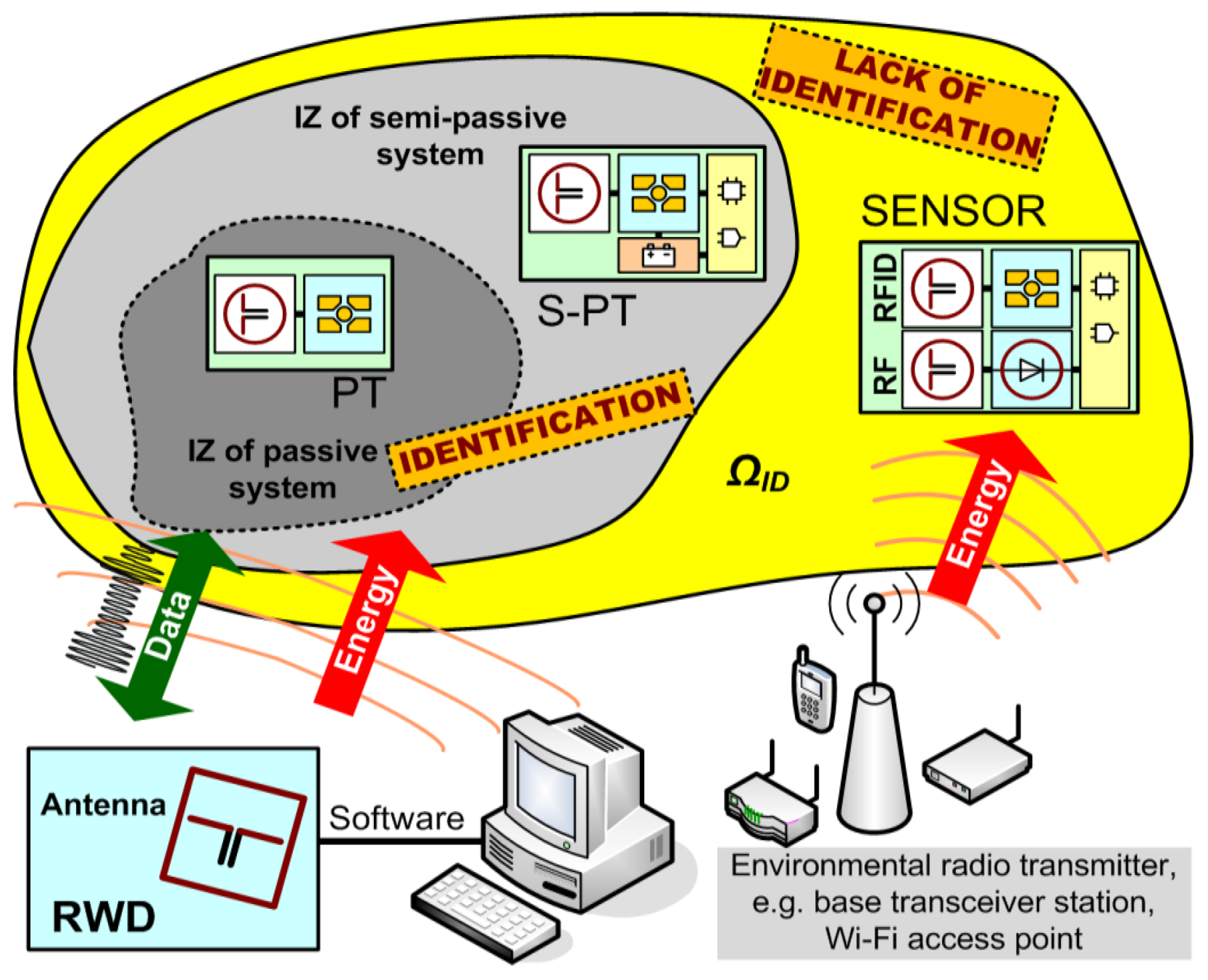
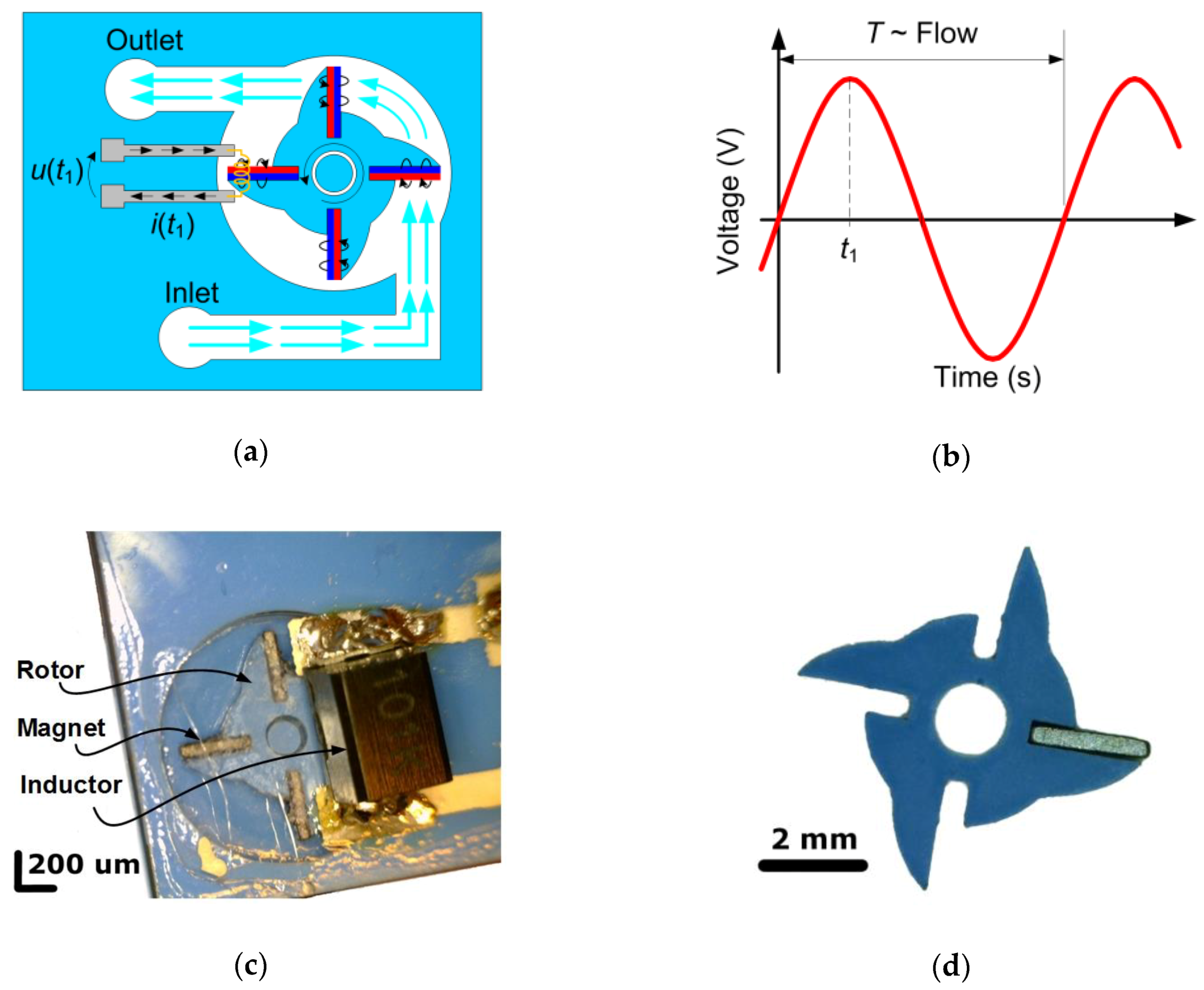
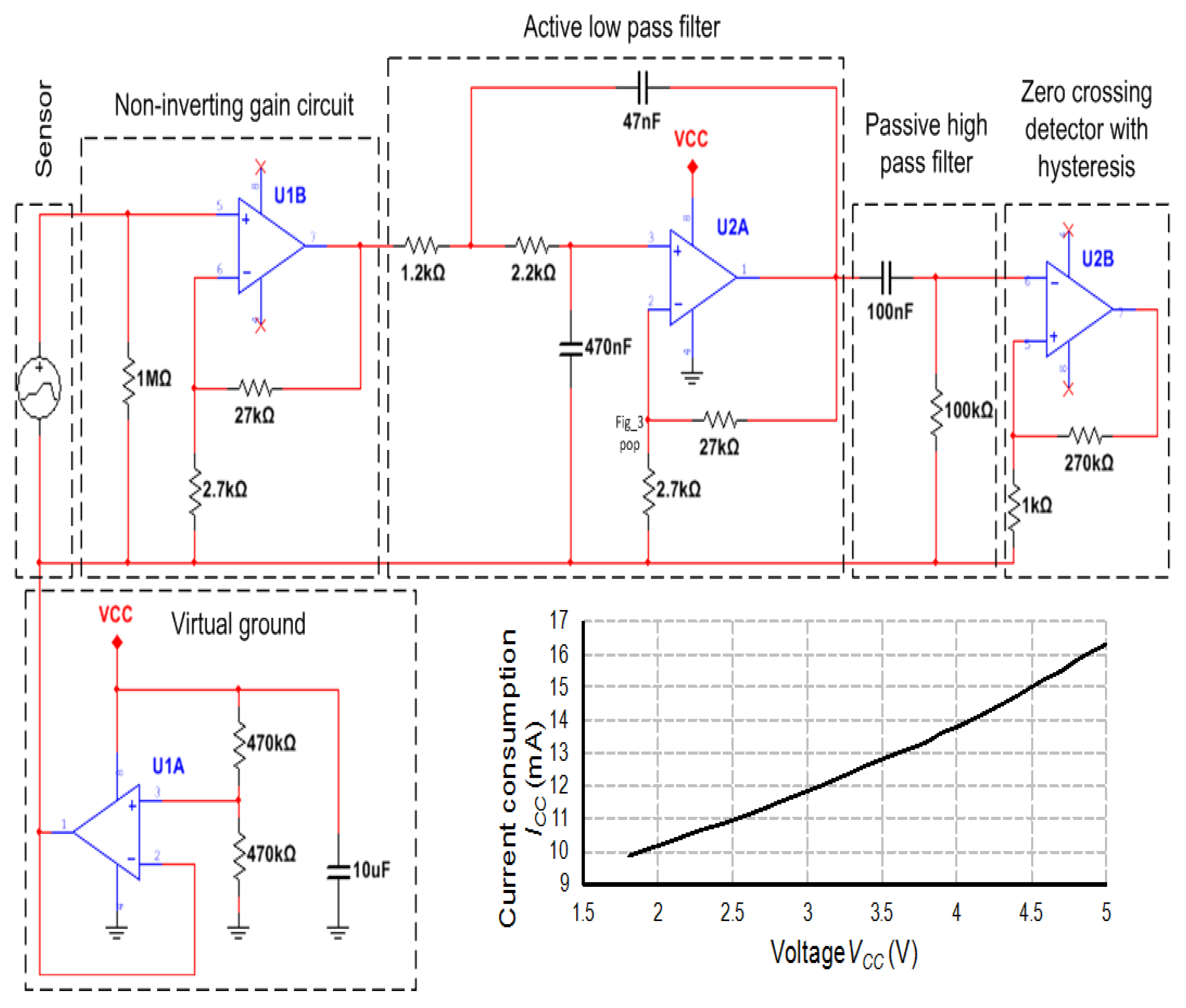
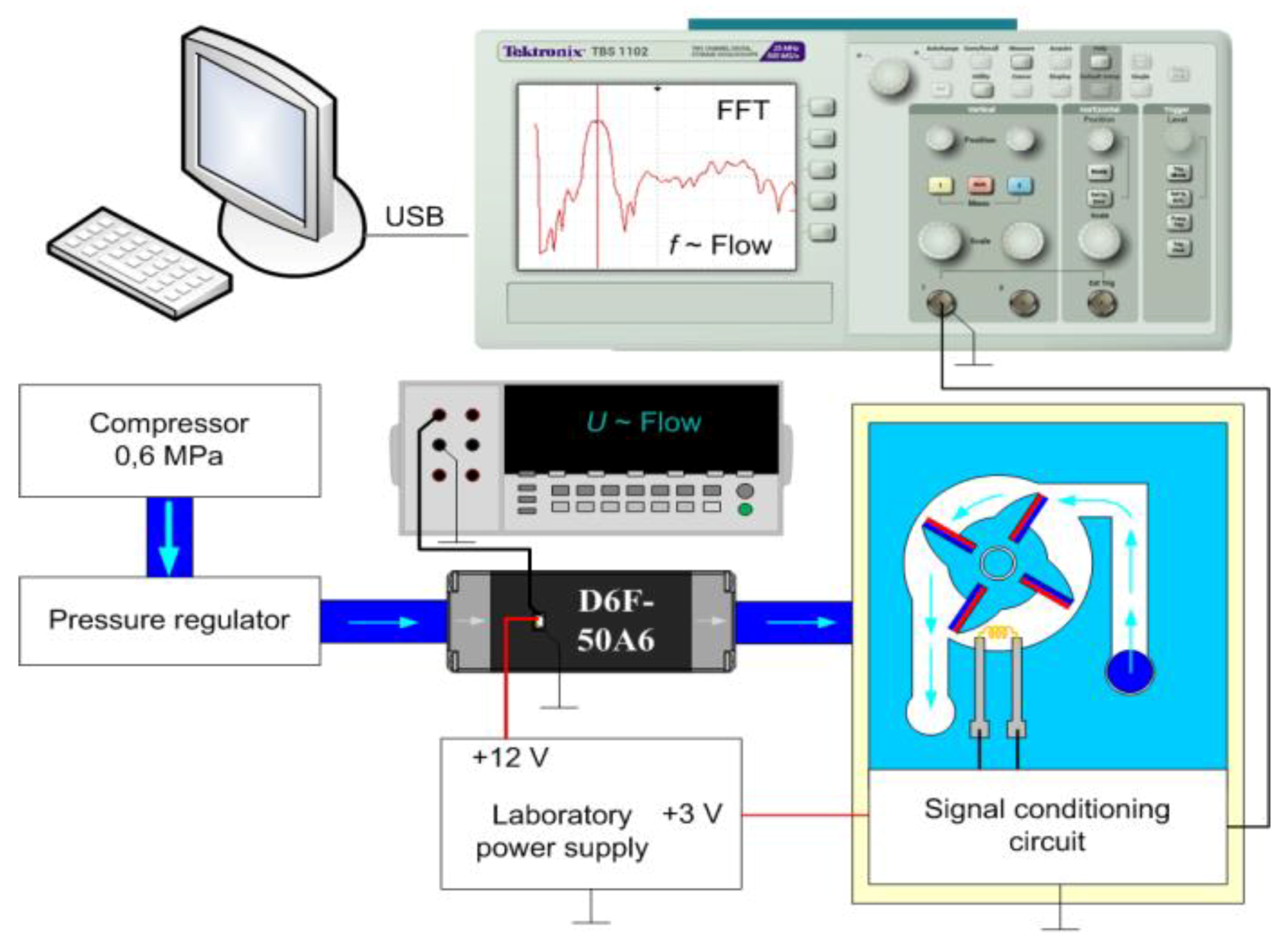
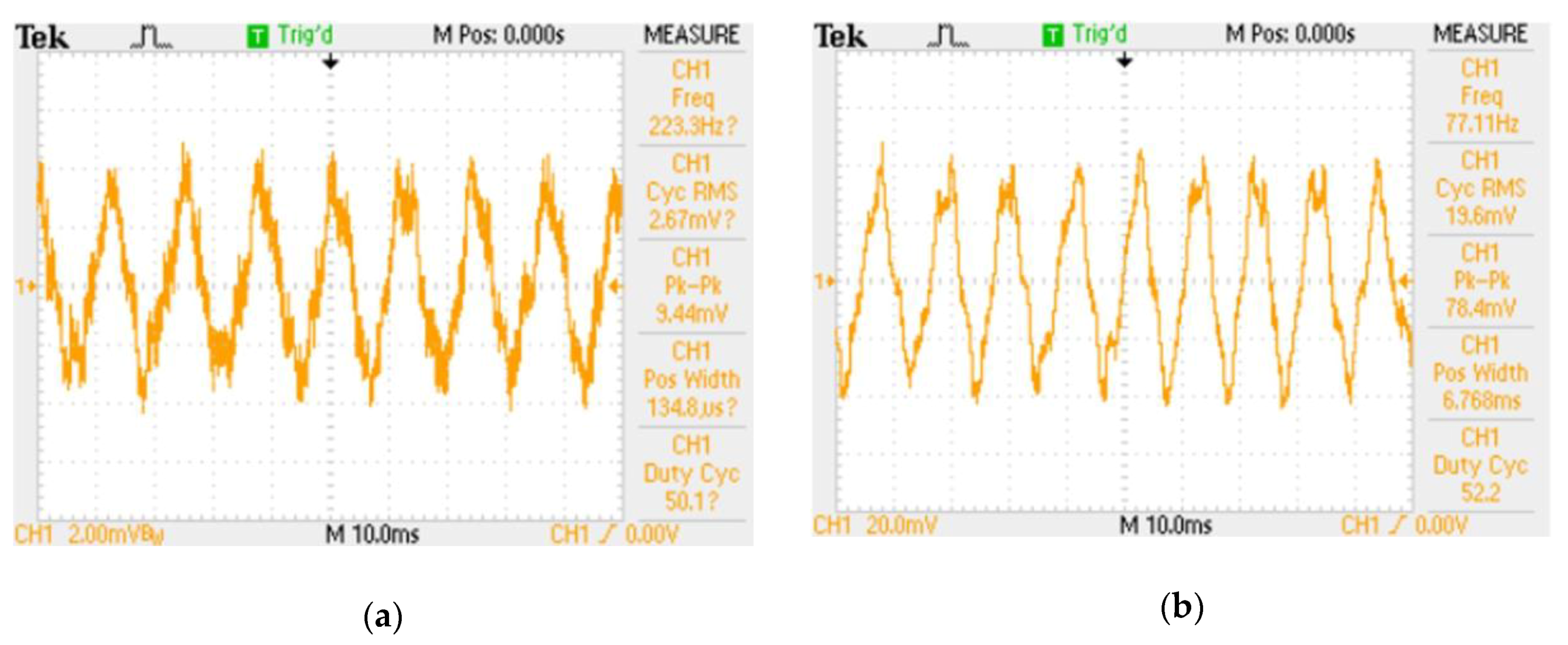
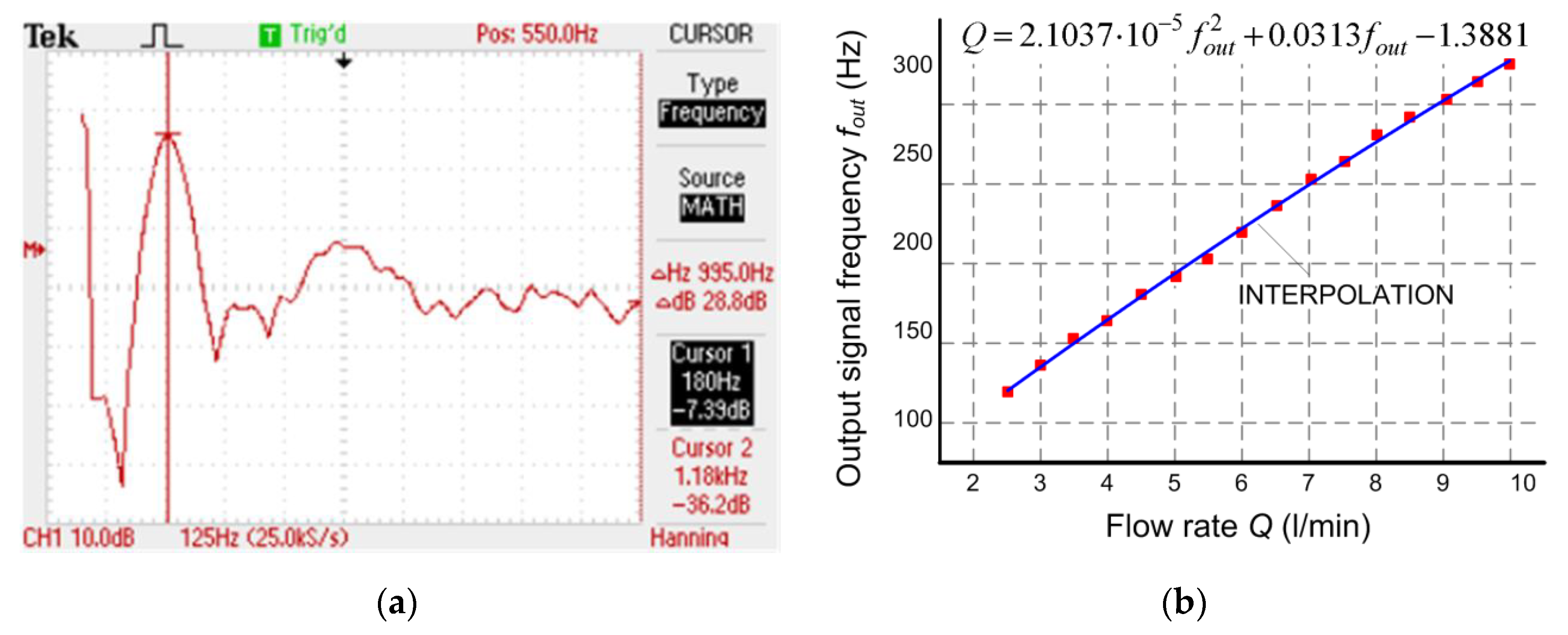
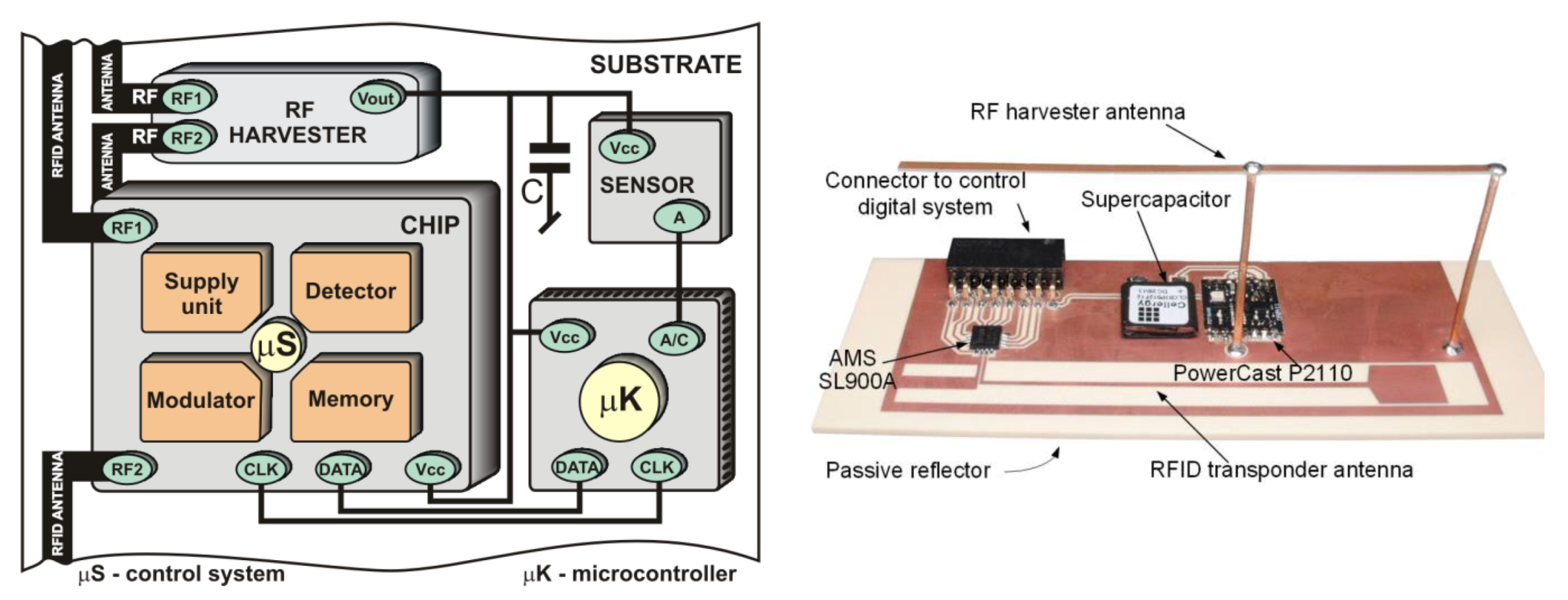



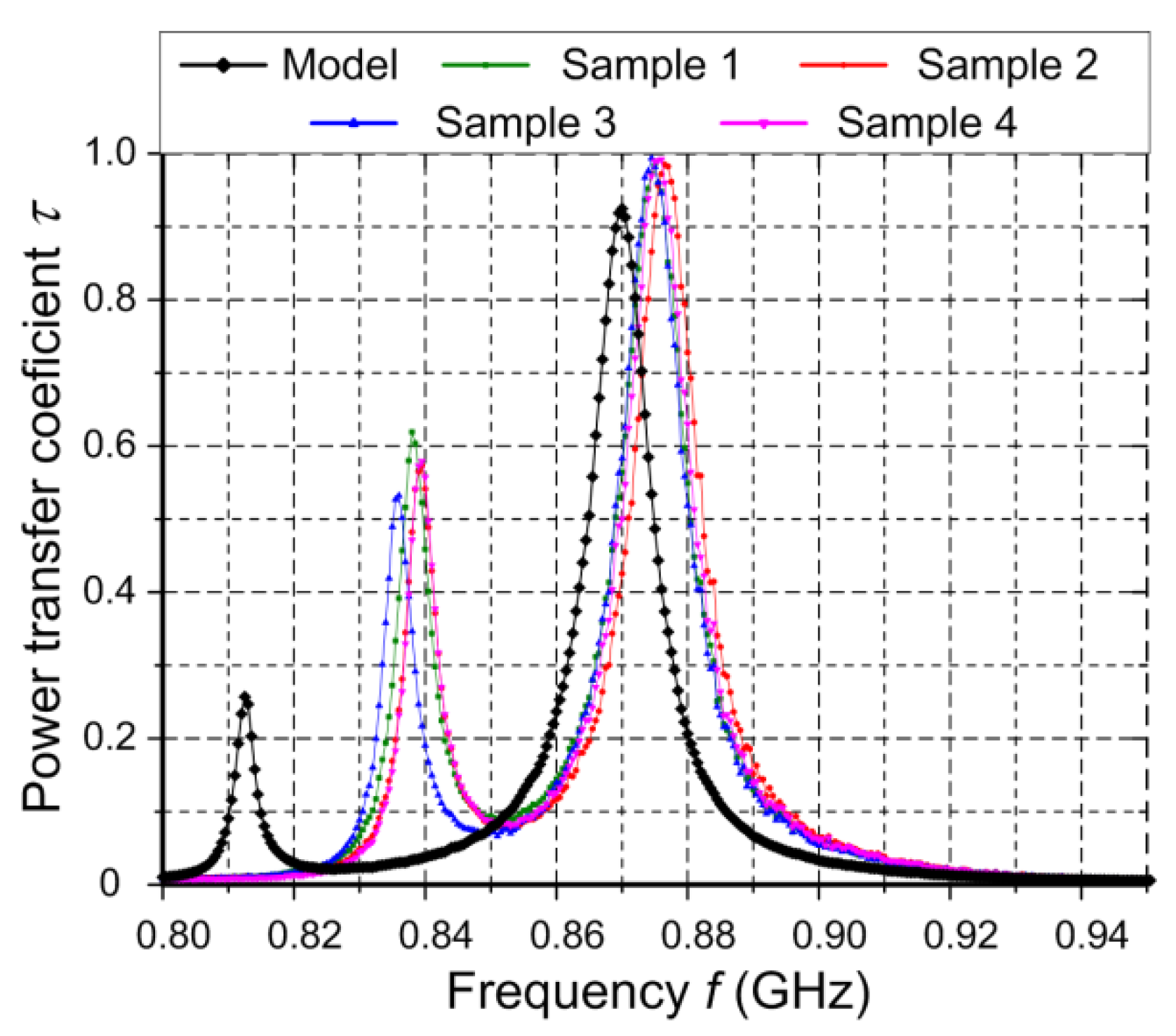
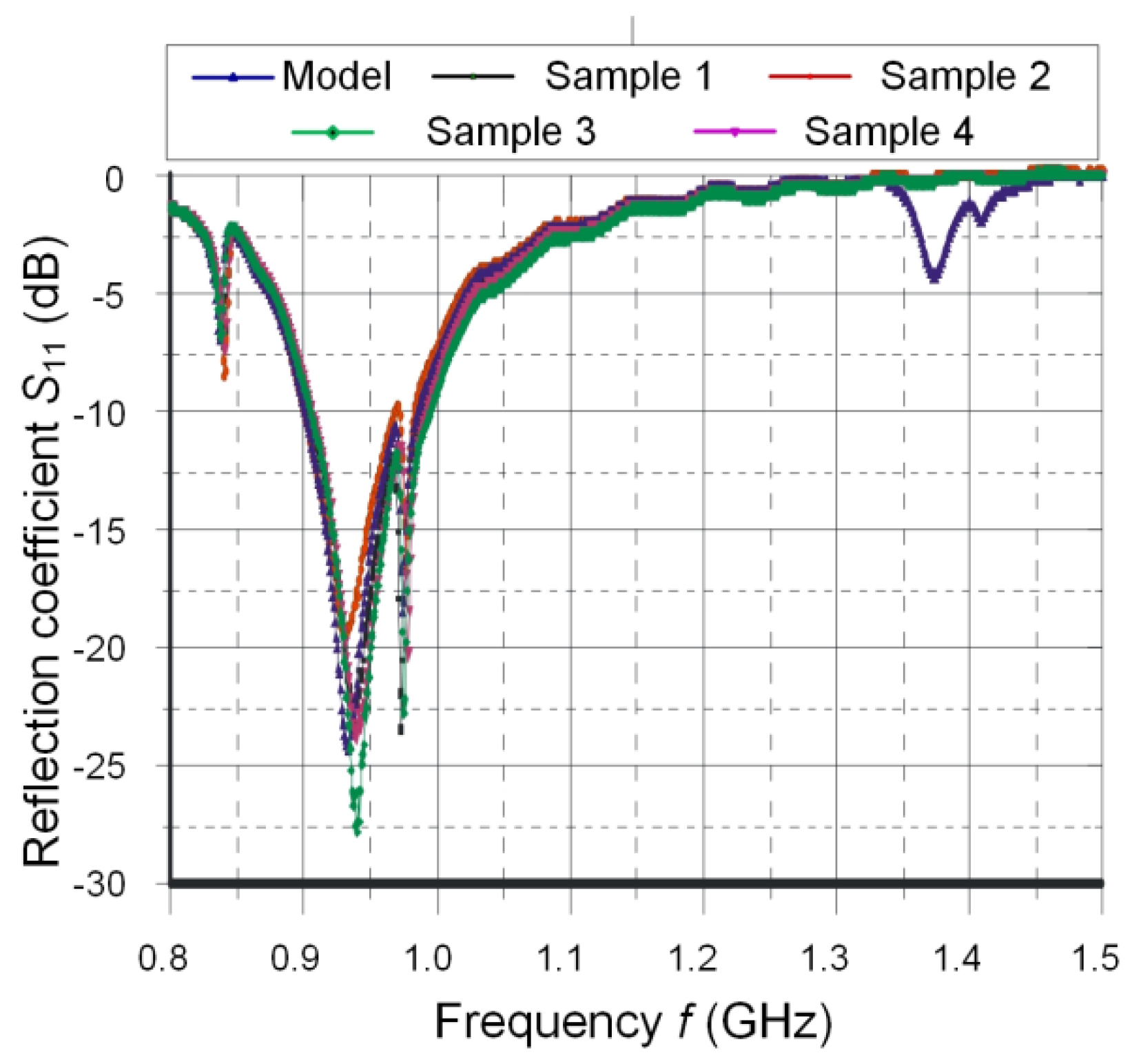
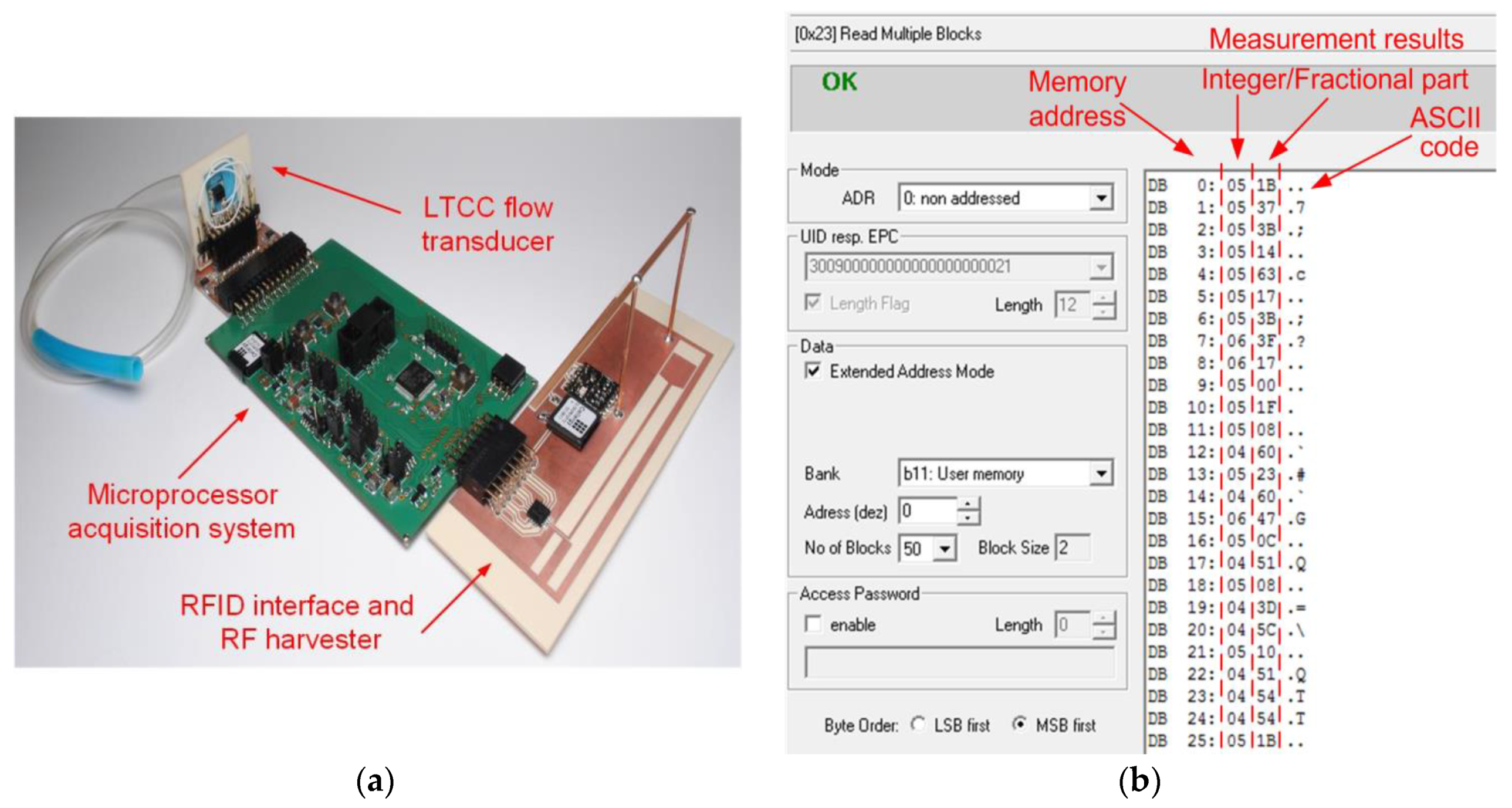
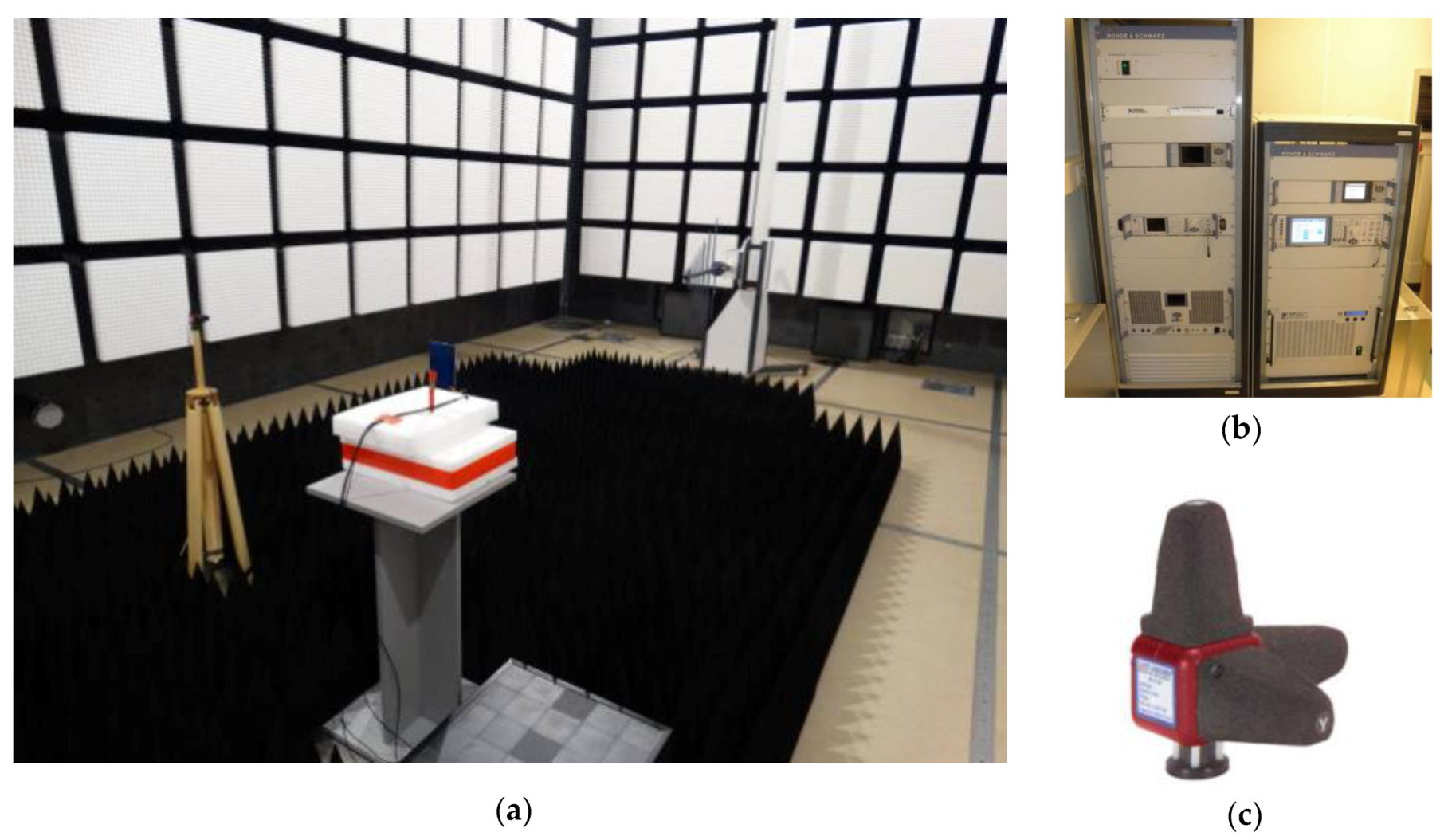
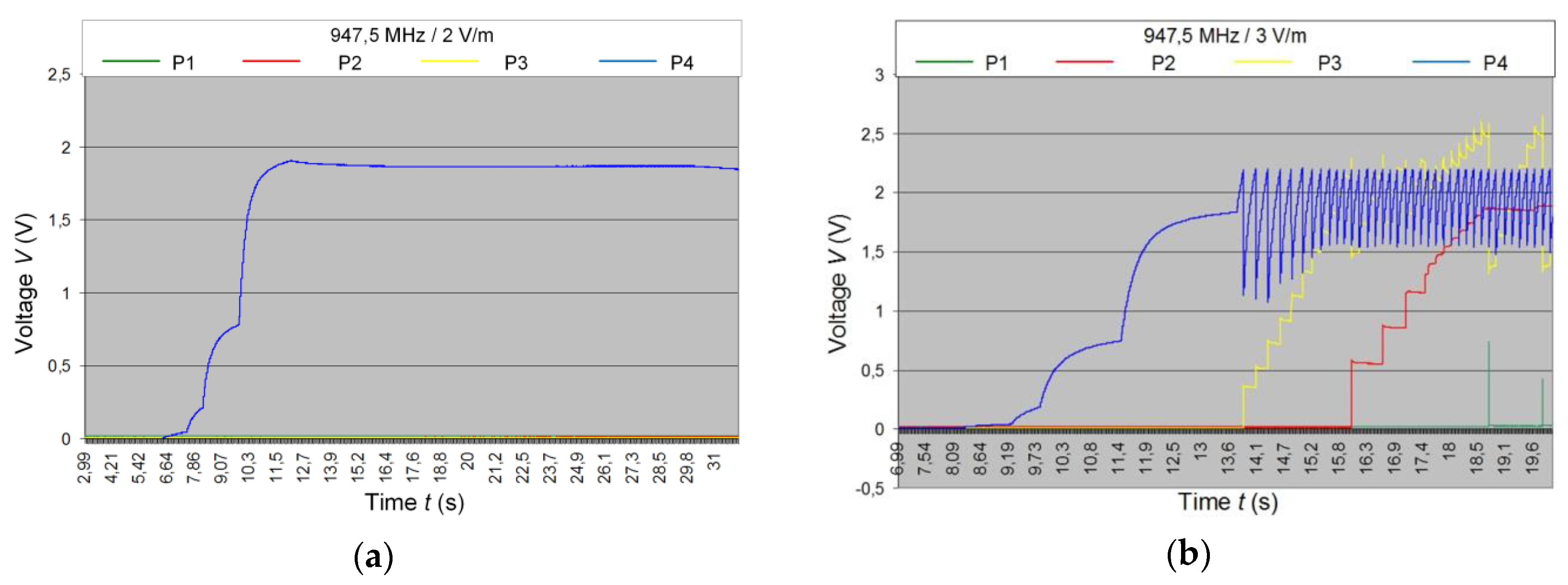
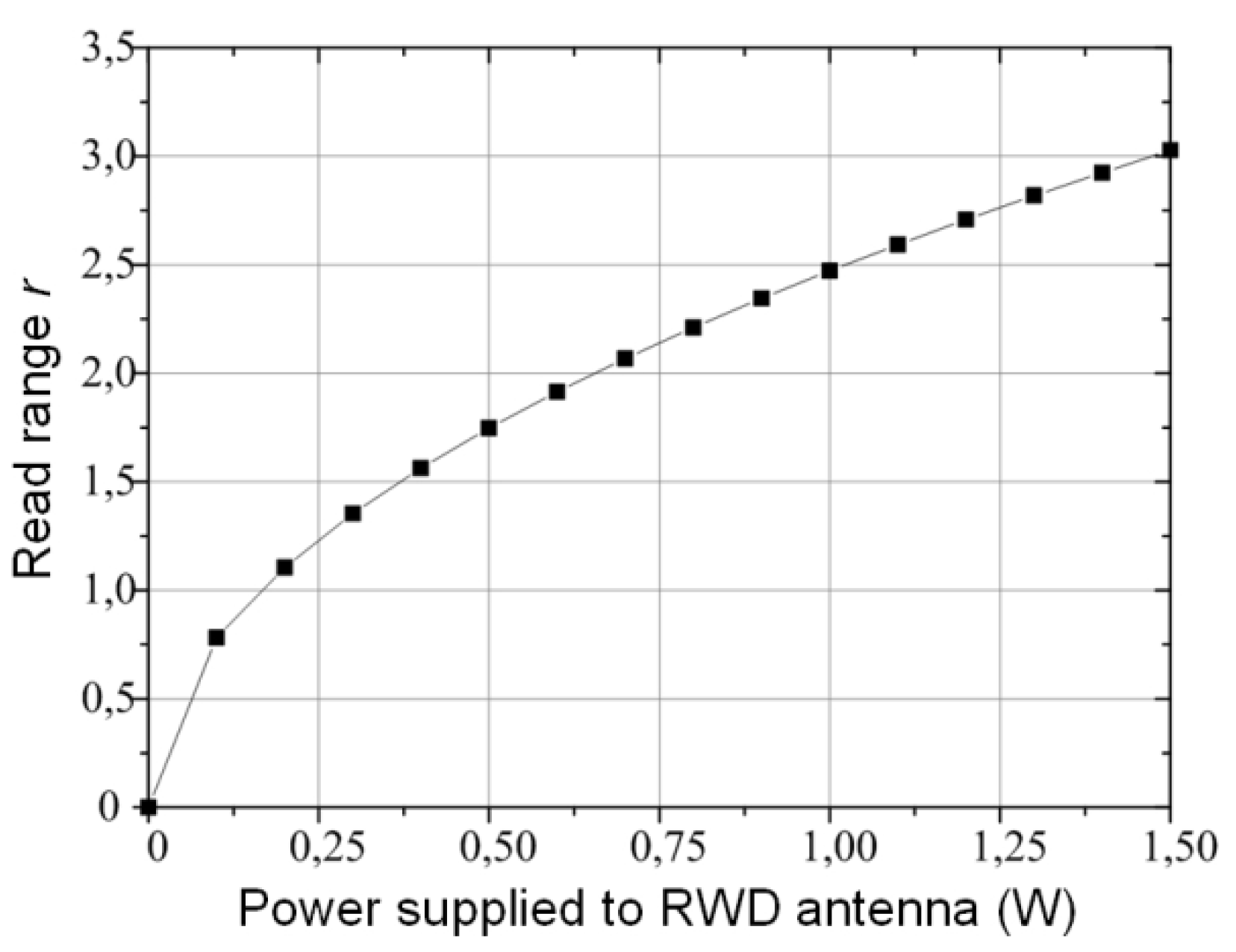
| Type of RFID Transponder | Activity in IZ | Activity outside IZ | Abbr. in Figure 1 |
|---|---|---|---|
| Passive transponders | Only identification | No active | PT |
| Semi-passive transponder | Identification and data acquisition | Data acquisition with battery | S-PT |
| Semi-passive transponder-sensor | Identification and data acquisition | Data acquisition without battery | SENSOR |
| Parameter | Sensor Presented in [6] | Sensor Presented in [5] | The Author’s Flow Sensor |
|---|---|---|---|
| Range of Input Signal | 6–17 ml/s (0.36–1 l/min) | 7–25 ml/s (0.42–1.5 l/min) | 25–167 ml/s (1.5–10 l/min) |
| Range of Output Signal | 70–420 Hz | 120–330 Hz | 110–300 Hz |
| Operating Pressure | <150 kPa | <150 kPa | <60 kPa |
| Current Consumption | 4.6–6.2 mA (optical elements + signal conditioner) | 4.6–6.2 mA (optical elements + signal conditioner) | 10–16 µA (generator of minute voltage + signal conditioner) |
| Technological Inaccuracy | ~100 µm stacking misalignment | ~100 µm stacking misalignment | ~50 µm milling inaccuracy |
© 2020 by the authors. Licensee MDPI, Basel, Switzerland. This article is an open access article distributed under the terms and conditions of the Creative Commons Attribution (CC BY) license (http://creativecommons.org/licenses/by/4.0/).
Share and Cite
Węglarski, M.; Jankowski-Mihułowicz, P.; Pitera, G.; Jurków, D.; Dorczyński, M. LTCC Flow Sensor with RFID Interface. Sensors 2020, 20, 268. https://doi.org/10.3390/s20010268
Węglarski M, Jankowski-Mihułowicz P, Pitera G, Jurków D, Dorczyński M. LTCC Flow Sensor with RFID Interface. Sensors. 2020; 20(1):268. https://doi.org/10.3390/s20010268
Chicago/Turabian StyleWęglarski, Mariusz, Piotr Jankowski-Mihułowicz, Grzegorz Pitera, Dominik Jurków, and Mateusz Dorczyński. 2020. "LTCC Flow Sensor with RFID Interface" Sensors 20, no. 1: 268. https://doi.org/10.3390/s20010268
APA StyleWęglarski, M., Jankowski-Mihułowicz, P., Pitera, G., Jurków, D., & Dorczyński, M. (2020). LTCC Flow Sensor with RFID Interface. Sensors, 20(1), 268. https://doi.org/10.3390/s20010268






